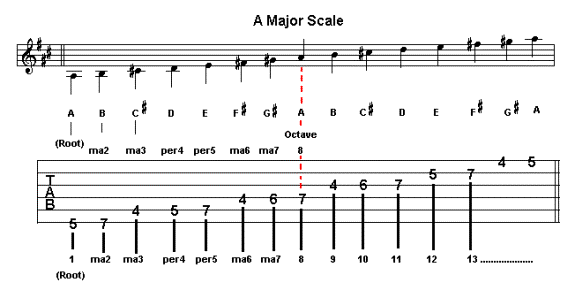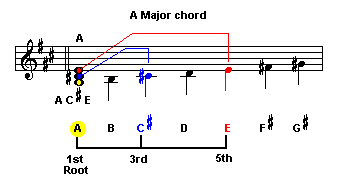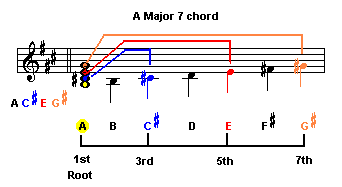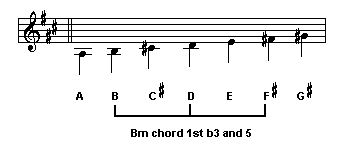Learning to
Harmonize
Most harmonized lines
whether played or sung by a vocalist, are built on notes known as chord
tones. Chord tones are the root, 3rd, 5th and the 7th
of any given scale. In the illustrations to follow, we will learn how to harmonize in thirds in the A major scale. We will stay within the diatonic structure of
this scale and cover up to 3 octaves. Recall that
diatonic means to stay within the scale, or use just the notes of a particular scale.
The illustration below
outlines the notes of the A major scale. The red line shows where the 2nd octave begins and the first ends.
From the (Root A to the next A 7th fret would be the 1st octave. Look below and notice the first A
note and second A note, this is the first octave. By playing the 2nd A note to the third A note would be
within the 2nd Octave, etc….
Look at the illustration once again, this time notice the notes that make up the A major scale. The notes are from the (Root A), B, C#, D, E, F#, G#. The diatonic major scale has 7 notes, with the 8th note the same as the 1st and repeating in sequence one octave higher. Each note following the root goes higher than the next. The root note is the lowest note in the key. For Example, the A note is the root note for the key of A major. The lowest C would be the root note in the key of C major.
The two illustrations below
will illustrate the key of A major covering two octaves. The bottom illustration is the same major key, but is shown in
tablature.

Under each of the notes
above are the abbreviations for each of the intervals of the major scale. We will not go into depth in this lesson, but
a brief explanation will do for now. We will cover each of the intervals down the road. What we’re concerned with in
this lesson is the (Major 3rd and the Minor 3rd). The Major
3rd is abbreviated above as ma3. In the key of A major the C# would be the major 3rd. Look above and notice the ma3 under the C# note.
The major 3rd is
always the third note in any major key. The major 3rd is always the 3rd note in a Major Triad.
Recall that a Triad is a chord, which uses 3 notes.
The major 3rd
note is (2 whole steps) or (4 half steps) away from the root or 1st note. Count the notes from the A below to
the C#. You would use all the notes including the sharps. (From the A note you would have, A#, B, C and the C#) This is
where the four-half steps come from. Recall that a half step equals one fret and a Whole step = 2 frets. So, four half
steps = 2 whole steps. The Major 3rd note is 2 whole steps away from the root.
The minor 3rd
would be 3 half steps or 1 and ½ whole steps. We know that in the key of A major the A chord is the A major chord. The B
chord in the key of A major is the B minor chord. Notice that the D note is only 3 half steps from the B. This would be a
minor 3rd.
The chords in the key of A
major are, A, Bm, C#m, D, E, F#m, G# diminished. Look at the illustration below and find the D note. The distance from
the D to the F# would be 2 whole steps, so the F# is a ma 3rd to the D. The notes in the D chord are D, F#
and A.
If you had a D minor chord,
the notes would be D F and A. Notice that the F is a minor 3rd now.

At the present time we are
only concerned with the major and the minor 3rd. Even the G# diminished chord above has a minor 3rd.
The notes of the G# diminished chord are, G#, B and D. By knowing this, it is possible to harmonize with any chord using
the 3rd interval. The 3rd interval will be either major or minor. The major 3rd is 2
whole steps from the root and the minor 3rd interval is 1 and ½ steps from the root.
Look at the key of C major.
The notes and chords of this key are C, Dm, Em, F, G, Am and B diminished. The notes of the C chord are C E G. These
notes are the 1st, 3rd and 5th notes of the scale. The 3rd of C major is the
E note. This would be a major 3rd since it is 2 whole steps from the C note.
Now lets look at the C minor
chord. The Cm chord has the notes C Eb and G. Notice that the E has been lowered by ½ step. This would now be a minor
3rd. The space between the C and Eb is now only 1 and ½ steps. So by lowering the 3rd note of the
major chord would make a minor chord.
With all this say, it’s
time to learn how to harmonize over any chord in the diatonic major scale. We will continue to use the key of A major.
Look at the illustration below

The illustration above shows
the notes in the key of A major. It also shows the notes that make up the A chord. The A chord uses the (1st
root, 3rd and 5th notes in the A major scale. Recall that a triad is a chord that uses three
notes. A chord is when you strum 3 or more notes simultaneously. When you harmonize you actually use the notes of each
chord or what are called chord forms. Chord forms are the 1st 3rd 5th and 7th
notes of the scale. The illustration above only shows the 1st 3rd and 5th chord tones
of the A major triad. The chord form would be every other note from the root note. The notes of this triad are the A C#
and E notes. If you wanted to harmonize in thirds over the A chord or A note, you would play the major 3rd
note or the C#.
Look at the illustration
below, it illustrates the A major scale with primary line and the harmony lines shown.

Harmonizing can be done with
two guitars or played with 1 guitar. Listen to the scorpions rock you like a Hurricane. The intro uses this technique.
Harmonizing is not only important when playing the guitar, but for vocals, keyboards and other instruments. You can
harmonize on other degrees of the scale too. You can harmonize on the 5th, and 7th too.
Look at the illustration
below. It shows the notes of the A major 7 chord. The A major 7 chord is built on the 1st 3rd 5th
and 7th notes of the scale.

The notes of the A major 7
chord are the A C# E and G#. You could play two guitars one playing the A note, one playing the C# note and then you
could sing the E note or G# note. This is how harmonizing works. You play the notes of the chord.
The notes of the Bm chord
are B D F#. All the chords can be figured out by taking every other note from the chord you would like to use. Look at
the notes of the Bm chord and C#m chord. Once again the notes of the Bm chord are B D and F#. The notes of the C#m
chord are C# E and G#. Put these notes down on paper.
F#
G#
D
E
B
C#

Notice the three notes F# D
and B, these are the Bm notes. Then we have the G# E and C#, the notes of the Cm chord. This just shows the 1st
3rd and 5th notes of each chord. Of course the 3rd is a minor 3rd for these
two chords. A minor 3rd is a flat 3rd. So for minor chords it would be 1,b3,5.
You would use the D note to
harmonize over the B note and the F# note to harmonize over the D note. You could also use the F# to harmonize over the
B note, this would be using the 5 over the 1, or harmonizing in 5ths.
Look at the illustration
below.

Once again this illustrates
the Amaj7 chord. The notes of the Amaj7 chord are A C# E and G#. Write these out on paper as shown below.
G#
E
C#
A
You would use the C# to
harmonize over the A note. Use the E note over the C# note, G# over the E note. Or you could play all 4 using four
different guitar parts. Or sing one note play one note; keyboard one note and so on.
The illustration below only
shows the key of A major which starts with the 5 and is the primary A major scale. Under this scale is the harmonizing
scale, which starts with the 4. Try to lay down the primary scale on tape and play the harmonizing scale over the
primary scale. Convert each of these scales to other keys and do the same thing. Also use the blank
tablature forms to figure out
this scale starting at different fret locations.

|
Check out the A major scale. | |
|
Check out the A major pentatonic scale. | |
|
Check out some A major Progressions. |
Good Luck,
Guitar Secrets



